Comprehensive Report: Cloud Computing Security and Privacy Issues
VerifiedAdded on 2020/03/16
|11
|2593
|64
Report
AI Summary
This report provides a comprehensive analysis of security and privacy issues in cloud computing. It begins with an executive summary highlighting the recurring problems of data security and privacy in information technology, especially in the context of cloud computing due to reduced user control and the storage of data in unknown locations. The report then examines the issues, discussing the vulnerabilities of virtual machines, the diversification of data across different servers, and the role of service providers and third-party members in compromising data security and privacy. The report also addresses issues not adequately covered by existing research, such as the security of interfaces, revenue-driven practices of service providers, and the complexity of cloud configurations. It then explores the impact of these issues on organizations and individuals, including the adoption of hybrid architectures and increased expenditures on security features. The report concludes with a reflection on the critical components that determine the nature of the report’s concerns and offers recommendations.
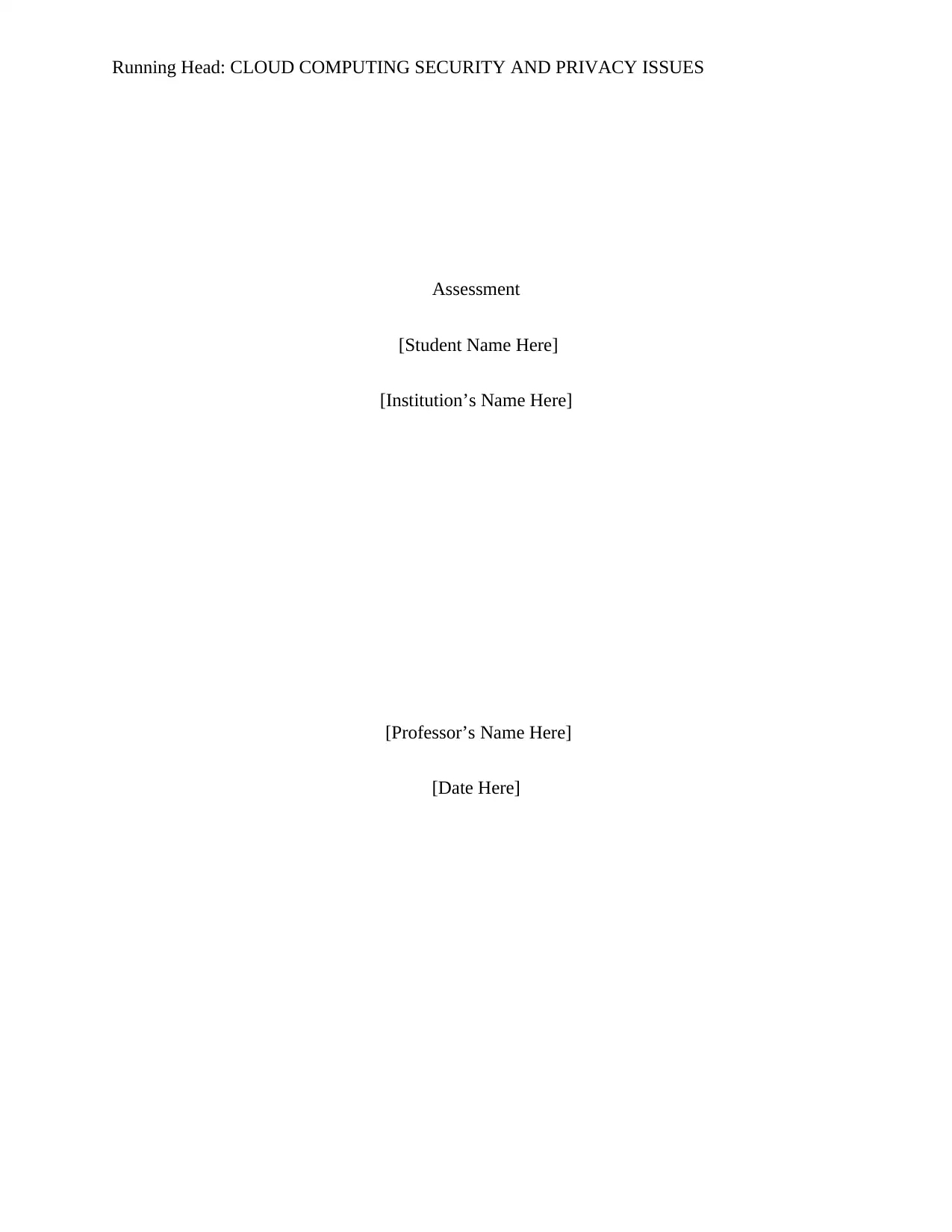
Running Head: CLOUD COMPUTING SECURITY AND PRIVACY ISSUES
Assessment
[Student Name Here]
[Institution’s Name Here]
[Professor’s Name Here]
[Date Here]
Assessment
[Student Name Here]
[Institution’s Name Here]
[Professor’s Name Here]
[Date Here]
Paraphrase This Document
Need a fresh take? Get an instant paraphrase of this document with our AI Paraphraser
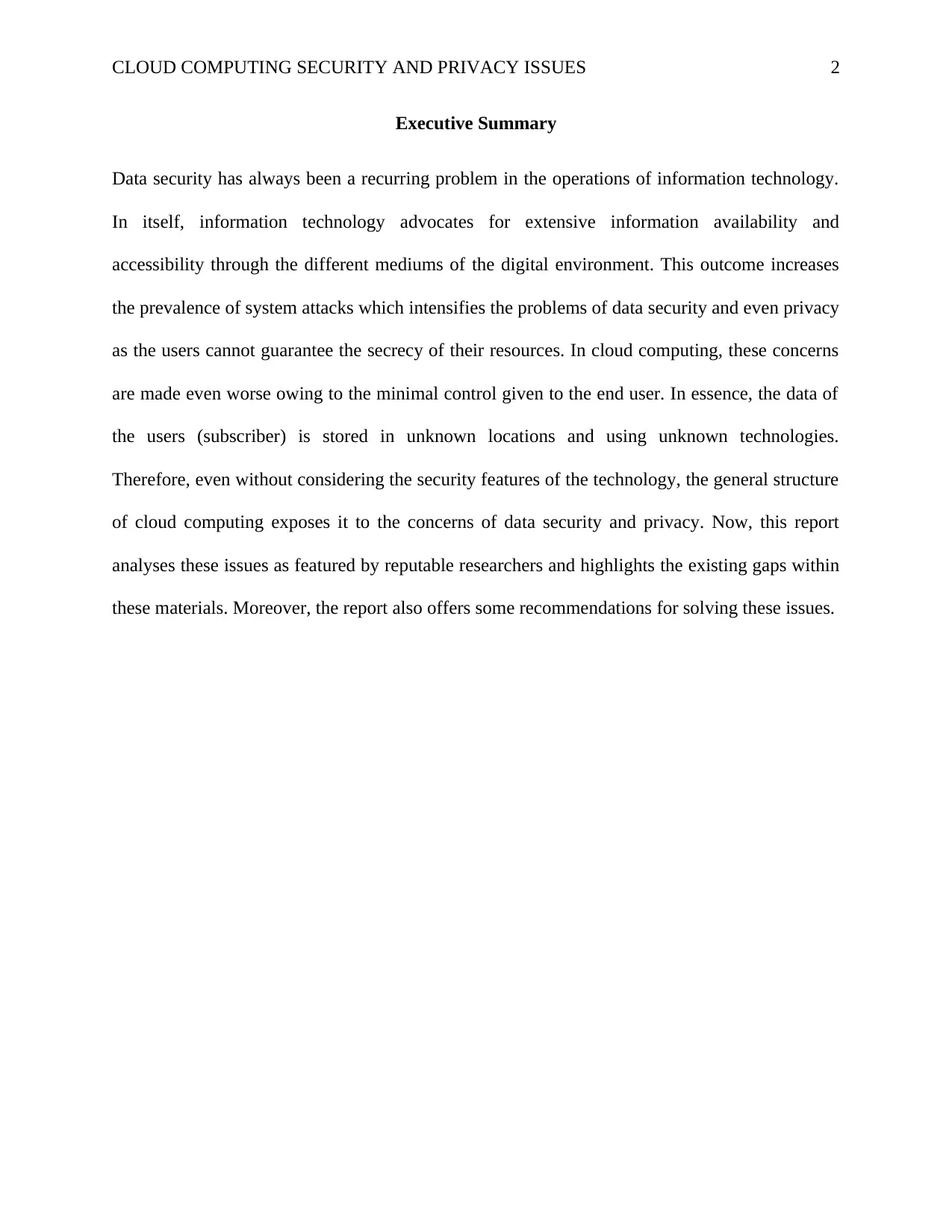
CLOUD COMPUTING SECURITY AND PRIVACY ISSUES 2
Executive Summary
Data security has always been a recurring problem in the operations of information technology.
In itself, information technology advocates for extensive information availability and
accessibility through the different mediums of the digital environment. This outcome increases
the prevalence of system attacks which intensifies the problems of data security and even privacy
as the users cannot guarantee the secrecy of their resources. In cloud computing, these concerns
are made even worse owing to the minimal control given to the end user. In essence, the data of
the users (subscriber) is stored in unknown locations and using unknown technologies.
Therefore, even without considering the security features of the technology, the general structure
of cloud computing exposes it to the concerns of data security and privacy. Now, this report
analyses these issues as featured by reputable researchers and highlights the existing gaps within
these materials. Moreover, the report also offers some recommendations for solving these issues.
Executive Summary
Data security has always been a recurring problem in the operations of information technology.
In itself, information technology advocates for extensive information availability and
accessibility through the different mediums of the digital environment. This outcome increases
the prevalence of system attacks which intensifies the problems of data security and even privacy
as the users cannot guarantee the secrecy of their resources. In cloud computing, these concerns
are made even worse owing to the minimal control given to the end user. In essence, the data of
the users (subscriber) is stored in unknown locations and using unknown technologies.
Therefore, even without considering the security features of the technology, the general structure
of cloud computing exposes it to the concerns of data security and privacy. Now, this report
analyses these issues as featured by reputable researchers and highlights the existing gaps within
these materials. Moreover, the report also offers some recommendations for solving these issues.
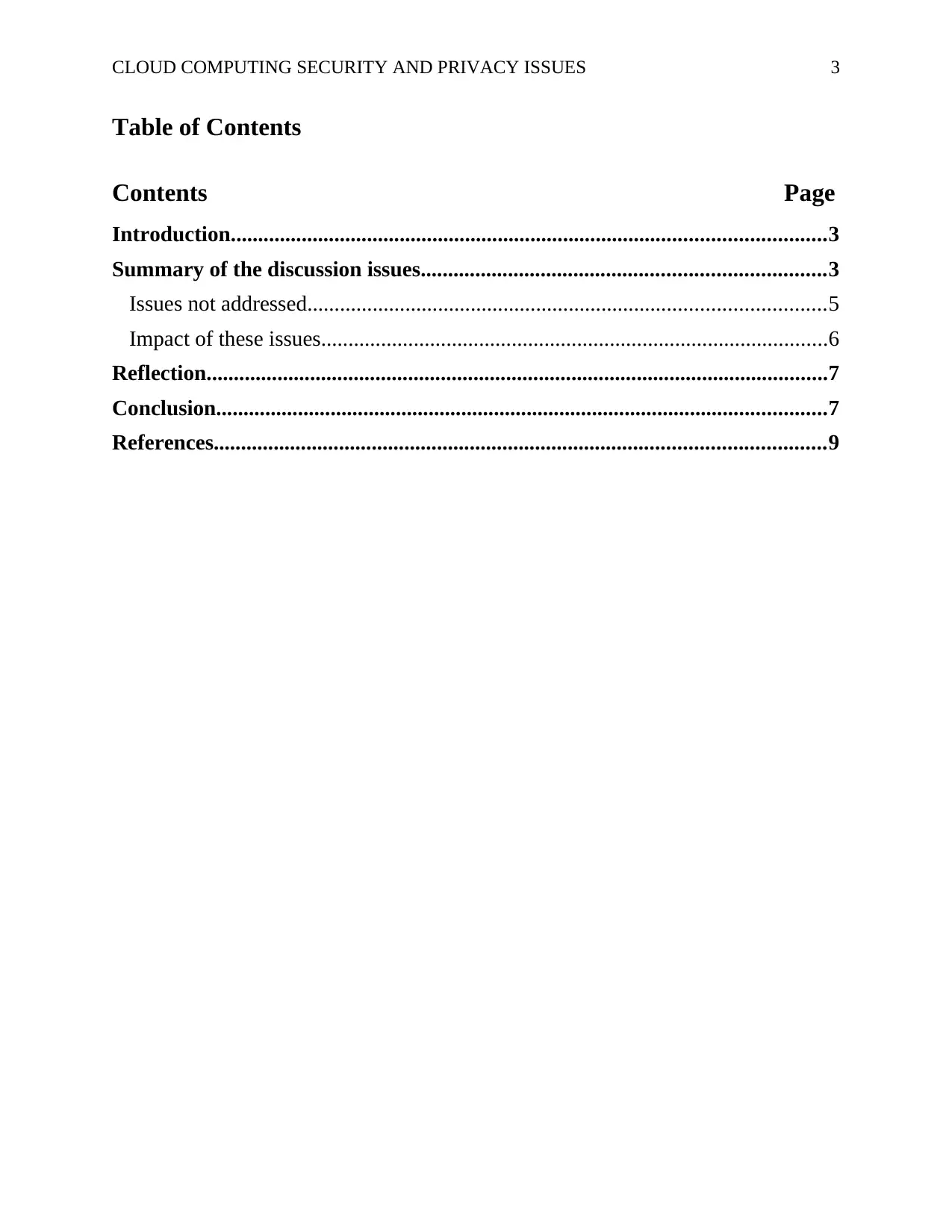
CLOUD COMPUTING SECURITY AND PRIVACY ISSUES 3
Table of Contents
Contents Page
Introduction.............................................................................................................3
Summary of the discussion issues..........................................................................3
Issues not addressed...............................................................................................5
Impact of these issues.............................................................................................6
Reflection..................................................................................................................7
Conclusion................................................................................................................7
References................................................................................................................9
Table of Contents
Contents Page
Introduction.............................................................................................................3
Summary of the discussion issues..........................................................................3
Issues not addressed...............................................................................................5
Impact of these issues.............................................................................................6
Reflection..................................................................................................................7
Conclusion................................................................................................................7
References................................................................................................................9
⊘ This is a preview!⊘
Do you want full access?
Subscribe today to unlock all pages.

Trusted by 1+ million students worldwide
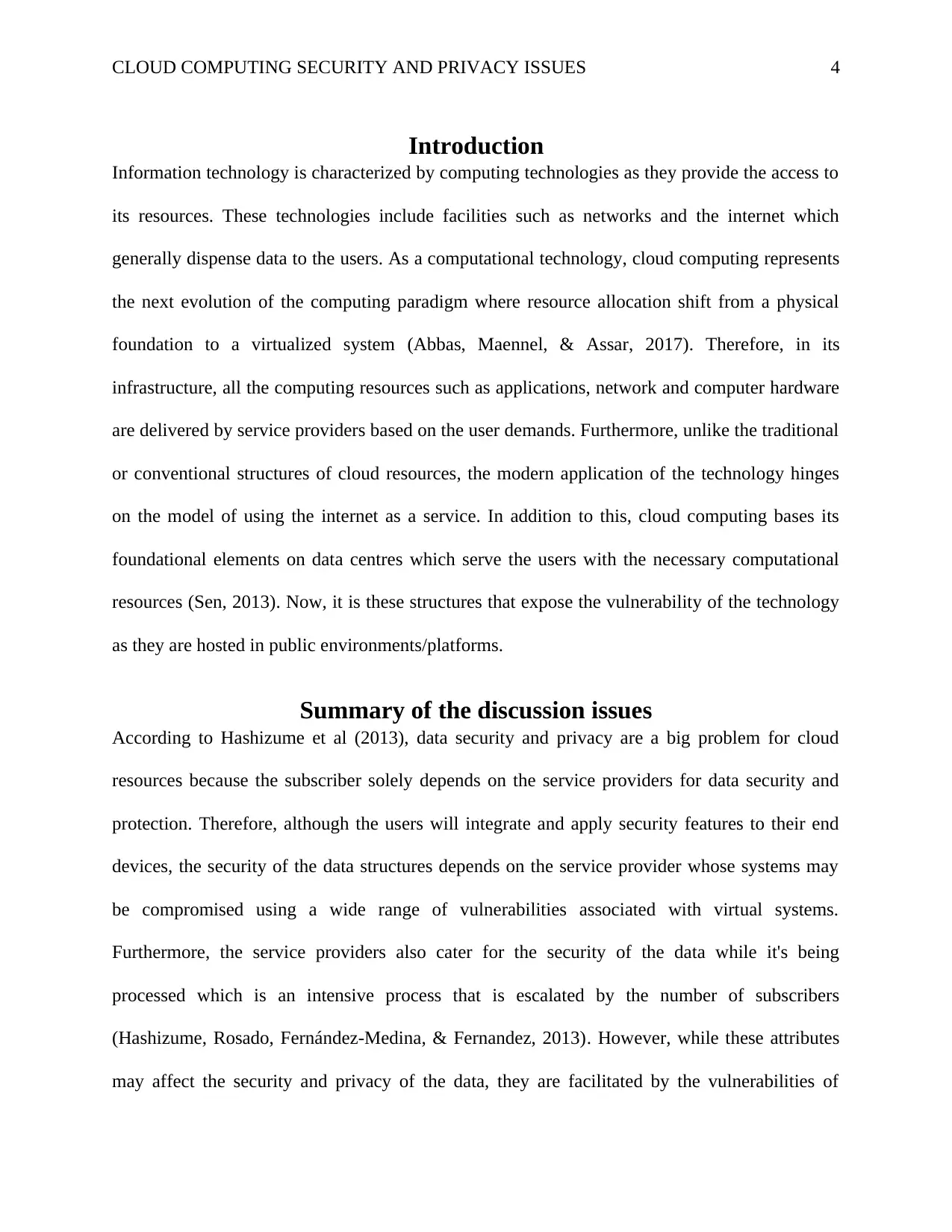
CLOUD COMPUTING SECURITY AND PRIVACY ISSUES 4
Introduction
Information technology is characterized by computing technologies as they provide the access to
its resources. These technologies include facilities such as networks and the internet which
generally dispense data to the users. As a computational technology, cloud computing represents
the next evolution of the computing paradigm where resource allocation shift from a physical
foundation to a virtualized system (Abbas, Maennel, & Assar, 2017). Therefore, in its
infrastructure, all the computing resources such as applications, network and computer hardware
are delivered by service providers based on the user demands. Furthermore, unlike the traditional
or conventional structures of cloud resources, the modern application of the technology hinges
on the model of using the internet as a service. In addition to this, cloud computing bases its
foundational elements on data centres which serve the users with the necessary computational
resources (Sen, 2013). Now, it is these structures that expose the vulnerability of the technology
as they are hosted in public environments/platforms.
Summary of the discussion issues
According to Hashizume et al (2013), data security and privacy are a big problem for cloud
resources because the subscriber solely depends on the service providers for data security and
protection. Therefore, although the users will integrate and apply security features to their end
devices, the security of the data structures depends on the service provider whose systems may
be compromised using a wide range of vulnerabilities associated with virtual systems.
Furthermore, the service providers also cater for the security of the data while it's being
processed which is an intensive process that is escalated by the number of subscribers
(Hashizume, Rosado, Fernández-Medina, & Fernandez, 2013). However, while these attributes
may affect the security and privacy of the data, they are facilitated by the vulnerabilities of
Introduction
Information technology is characterized by computing technologies as they provide the access to
its resources. These technologies include facilities such as networks and the internet which
generally dispense data to the users. As a computational technology, cloud computing represents
the next evolution of the computing paradigm where resource allocation shift from a physical
foundation to a virtualized system (Abbas, Maennel, & Assar, 2017). Therefore, in its
infrastructure, all the computing resources such as applications, network and computer hardware
are delivered by service providers based on the user demands. Furthermore, unlike the traditional
or conventional structures of cloud resources, the modern application of the technology hinges
on the model of using the internet as a service. In addition to this, cloud computing bases its
foundational elements on data centres which serve the users with the necessary computational
resources (Sen, 2013). Now, it is these structures that expose the vulnerability of the technology
as they are hosted in public environments/platforms.
Summary of the discussion issues
According to Hashizume et al (2013), data security and privacy are a big problem for cloud
resources because the subscriber solely depends on the service providers for data security and
protection. Therefore, although the users will integrate and apply security features to their end
devices, the security of the data structures depends on the service provider whose systems may
be compromised using a wide range of vulnerabilities associated with virtual systems.
Furthermore, the service providers also cater for the security of the data while it's being
processed which is an intensive process that is escalated by the number of subscribers
(Hashizume, Rosado, Fernández-Medina, & Fernandez, 2013). However, while these attributes
may affect the security and privacy of the data, they are facilitated by the vulnerabilities of
Paraphrase This Document
Need a fresh take? Get an instant paraphrase of this document with our AI Paraphraser
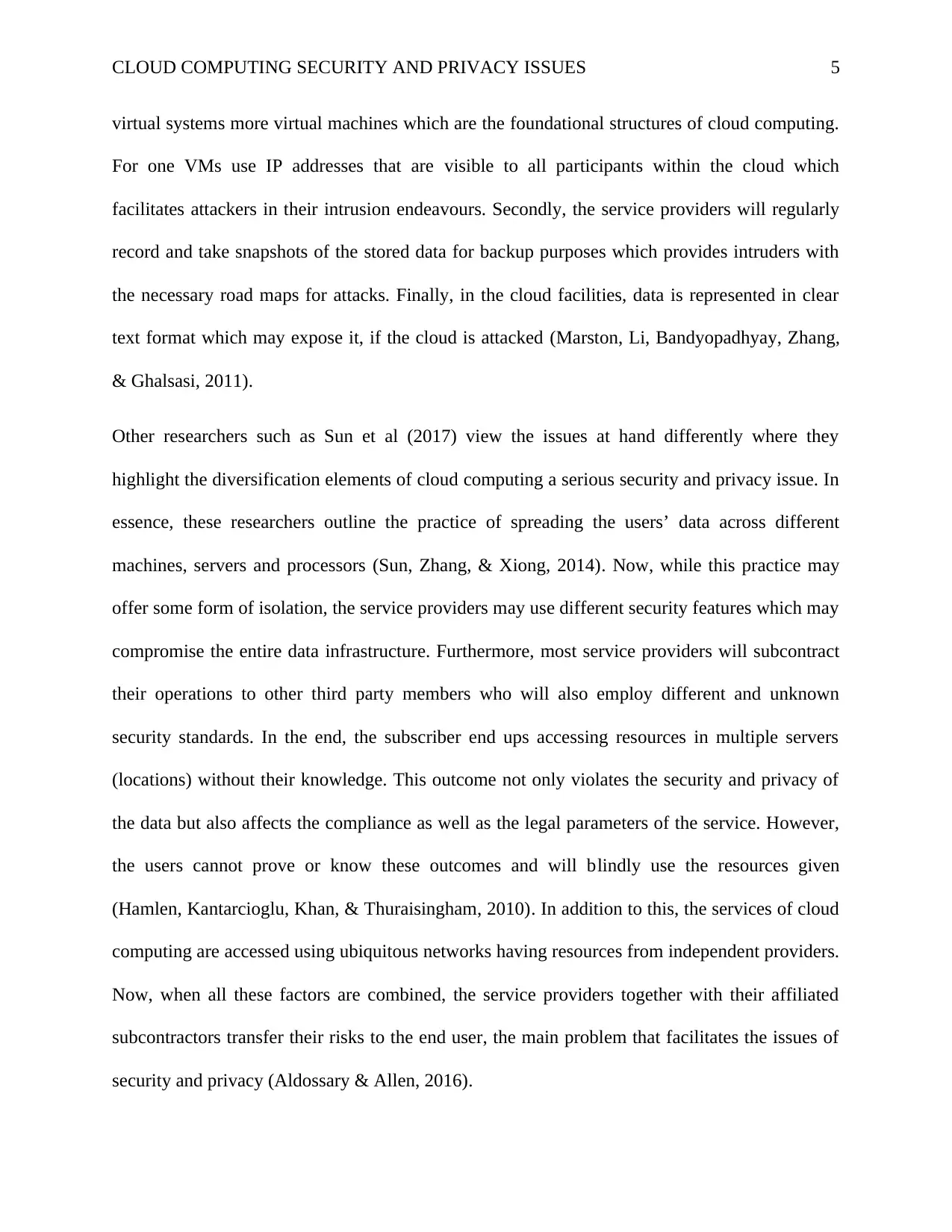
CLOUD COMPUTING SECURITY AND PRIVACY ISSUES 5
virtual systems more virtual machines which are the foundational structures of cloud computing.
For one VMs use IP addresses that are visible to all participants within the cloud which
facilitates attackers in their intrusion endeavours. Secondly, the service providers will regularly
record and take snapshots of the stored data for backup purposes which provides intruders with
the necessary road maps for attacks. Finally, in the cloud facilities, data is represented in clear
text format which may expose it, if the cloud is attacked (Marston, Li, Bandyopadhyay, Zhang,
& Ghalsasi, 2011).
Other researchers such as Sun et al (2017) view the issues at hand differently where they
highlight the diversification elements of cloud computing a serious security and privacy issue. In
essence, these researchers outline the practice of spreading the users’ data across different
machines, servers and processors (Sun, Zhang, & Xiong, 2014). Now, while this practice may
offer some form of isolation, the service providers may use different security features which may
compromise the entire data infrastructure. Furthermore, most service providers will subcontract
their operations to other third party members who will also employ different and unknown
security standards. In the end, the subscriber end ups accessing resources in multiple servers
(locations) without their knowledge. This outcome not only violates the security and privacy of
the data but also affects the compliance as well as the legal parameters of the service. However,
the users cannot prove or know these outcomes and will blindly use the resources given
(Hamlen, Kantarcioglu, Khan, & Thuraisingham, 2010). In addition to this, the services of cloud
computing are accessed using ubiquitous networks having resources from independent providers.
Now, when all these factors are combined, the service providers together with their affiliated
subcontractors transfer their risks to the end user, the main problem that facilitates the issues of
security and privacy (Aldossary & Allen, 2016).
virtual systems more virtual machines which are the foundational structures of cloud computing.
For one VMs use IP addresses that are visible to all participants within the cloud which
facilitates attackers in their intrusion endeavours. Secondly, the service providers will regularly
record and take snapshots of the stored data for backup purposes which provides intruders with
the necessary road maps for attacks. Finally, in the cloud facilities, data is represented in clear
text format which may expose it, if the cloud is attacked (Marston, Li, Bandyopadhyay, Zhang,
& Ghalsasi, 2011).
Other researchers such as Sun et al (2017) view the issues at hand differently where they
highlight the diversification elements of cloud computing a serious security and privacy issue. In
essence, these researchers outline the practice of spreading the users’ data across different
machines, servers and processors (Sun, Zhang, & Xiong, 2014). Now, while this practice may
offer some form of isolation, the service providers may use different security features which may
compromise the entire data infrastructure. Furthermore, most service providers will subcontract
their operations to other third party members who will also employ different and unknown
security standards. In the end, the subscriber end ups accessing resources in multiple servers
(locations) without their knowledge. This outcome not only violates the security and privacy of
the data but also affects the compliance as well as the legal parameters of the service. However,
the users cannot prove or know these outcomes and will blindly use the resources given
(Hamlen, Kantarcioglu, Khan, & Thuraisingham, 2010). In addition to this, the services of cloud
computing are accessed using ubiquitous networks having resources from independent providers.
Now, when all these factors are combined, the service providers together with their affiliated
subcontractors transfer their risks to the end user, the main problem that facilitates the issues of
security and privacy (Aldossary & Allen, 2016).
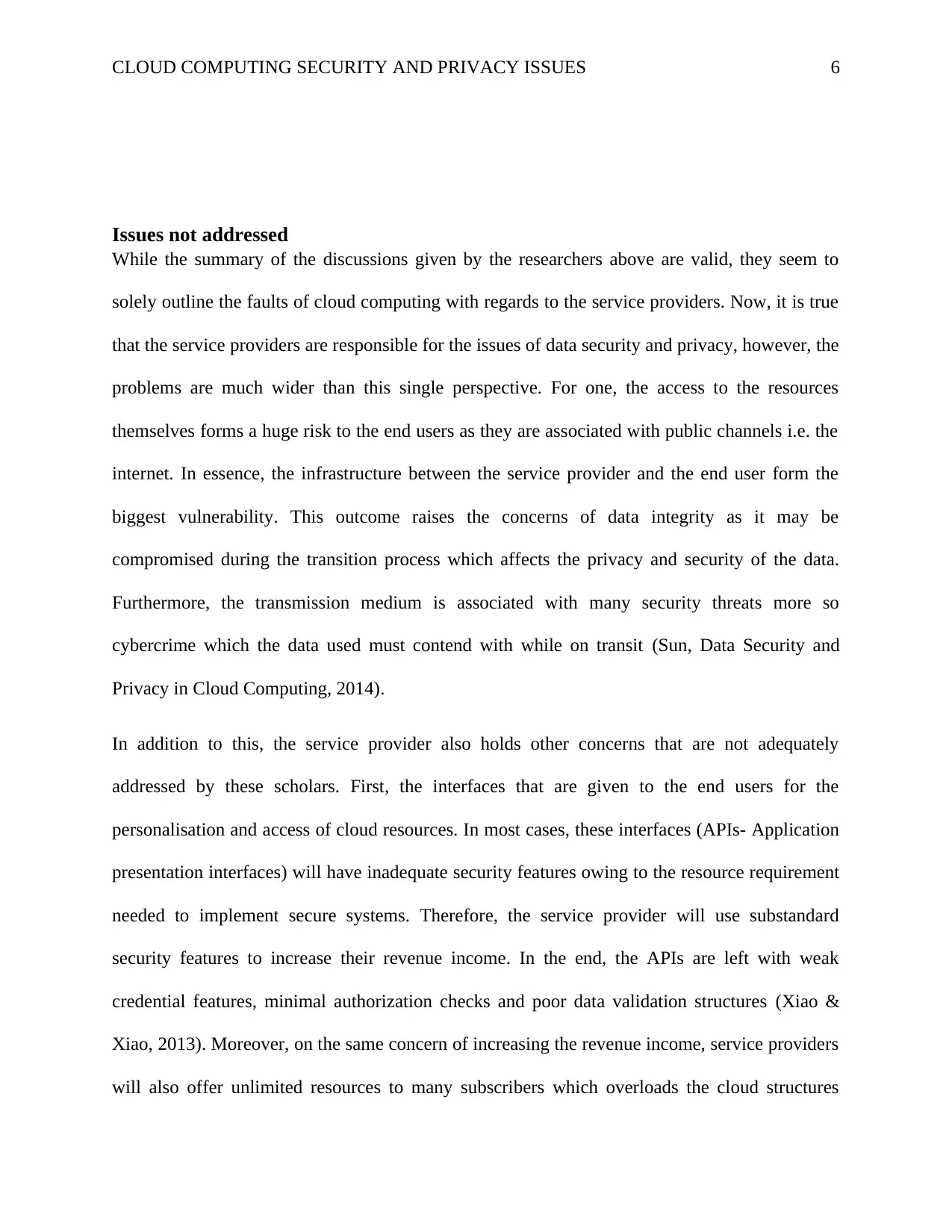
CLOUD COMPUTING SECURITY AND PRIVACY ISSUES 6
Issues not addressed
While the summary of the discussions given by the researchers above are valid, they seem to
solely outline the faults of cloud computing with regards to the service providers. Now, it is true
that the service providers are responsible for the issues of data security and privacy, however, the
problems are much wider than this single perspective. For one, the access to the resources
themselves forms a huge risk to the end users as they are associated with public channels i.e. the
internet. In essence, the infrastructure between the service provider and the end user form the
biggest vulnerability. This outcome raises the concerns of data integrity as it may be
compromised during the transition process which affects the privacy and security of the data.
Furthermore, the transmission medium is associated with many security threats more so
cybercrime which the data used must contend with while on transit (Sun, Data Security and
Privacy in Cloud Computing, 2014).
In addition to this, the service provider also holds other concerns that are not adequately
addressed by these scholars. First, the interfaces that are given to the end users for the
personalisation and access of cloud resources. In most cases, these interfaces (APIs- Application
presentation interfaces) will have inadequate security features owing to the resource requirement
needed to implement secure systems. Therefore, the service provider will use substandard
security features to increase their revenue income. In the end, the APIs are left with weak
credential features, minimal authorization checks and poor data validation structures (Xiao &
Xiao, 2013). Moreover, on the same concern of increasing the revenue income, service providers
will also offer unlimited resources to many subscribers which overloads the cloud structures
Issues not addressed
While the summary of the discussions given by the researchers above are valid, they seem to
solely outline the faults of cloud computing with regards to the service providers. Now, it is true
that the service providers are responsible for the issues of data security and privacy, however, the
problems are much wider than this single perspective. For one, the access to the resources
themselves forms a huge risk to the end users as they are associated with public channels i.e. the
internet. In essence, the infrastructure between the service provider and the end user form the
biggest vulnerability. This outcome raises the concerns of data integrity as it may be
compromised during the transition process which affects the privacy and security of the data.
Furthermore, the transmission medium is associated with many security threats more so
cybercrime which the data used must contend with while on transit (Sun, Data Security and
Privacy in Cloud Computing, 2014).
In addition to this, the service provider also holds other concerns that are not adequately
addressed by these scholars. First, the interfaces that are given to the end users for the
personalisation and access of cloud resources. In most cases, these interfaces (APIs- Application
presentation interfaces) will have inadequate security features owing to the resource requirement
needed to implement secure systems. Therefore, the service provider will use substandard
security features to increase their revenue income. In the end, the APIs are left with weak
credential features, minimal authorization checks and poor data validation structures (Xiao &
Xiao, 2013). Moreover, on the same concern of increasing the revenue income, service providers
will also offer unlimited resources to many subscribers which overloads the cloud structures
⊘ This is a preview!⊘
Do you want full access?
Subscribe today to unlock all pages.

Trusted by 1+ million students worldwide
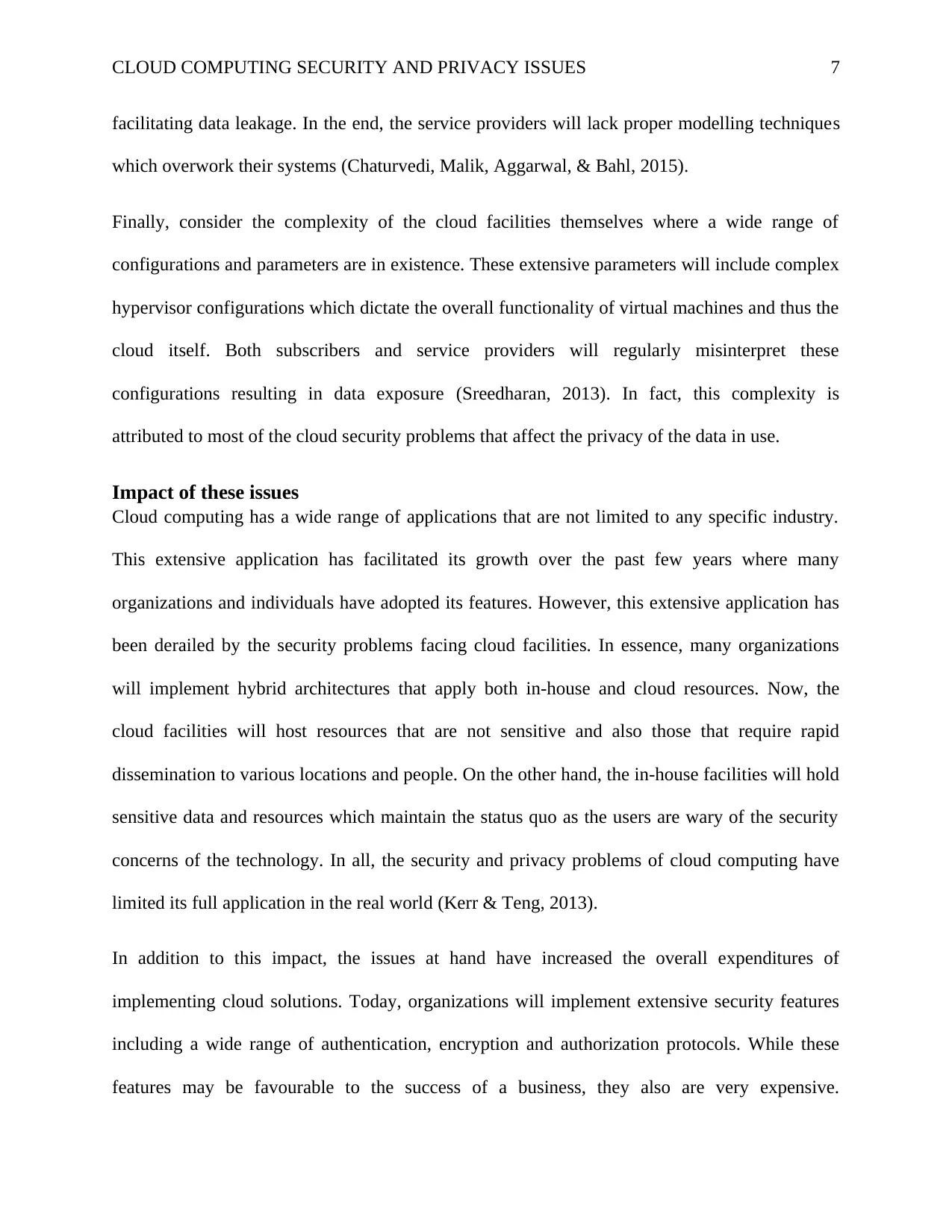
CLOUD COMPUTING SECURITY AND PRIVACY ISSUES 7
facilitating data leakage. In the end, the service providers will lack proper modelling techniques
which overwork their systems (Chaturvedi, Malik, Aggarwal, & Bahl, 2015).
Finally, consider the complexity of the cloud facilities themselves where a wide range of
configurations and parameters are in existence. These extensive parameters will include complex
hypervisor configurations which dictate the overall functionality of virtual machines and thus the
cloud itself. Both subscribers and service providers will regularly misinterpret these
configurations resulting in data exposure (Sreedharan, 2013). In fact, this complexity is
attributed to most of the cloud security problems that affect the privacy of the data in use.
Impact of these issues
Cloud computing has a wide range of applications that are not limited to any specific industry.
This extensive application has facilitated its growth over the past few years where many
organizations and individuals have adopted its features. However, this extensive application has
been derailed by the security problems facing cloud facilities. In essence, many organizations
will implement hybrid architectures that apply both in-house and cloud resources. Now, the
cloud facilities will host resources that are not sensitive and also those that require rapid
dissemination to various locations and people. On the other hand, the in-house facilities will hold
sensitive data and resources which maintain the status quo as the users are wary of the security
concerns of the technology. In all, the security and privacy problems of cloud computing have
limited its full application in the real world (Kerr & Teng, 2013).
In addition to this impact, the issues at hand have increased the overall expenditures of
implementing cloud solutions. Today, organizations will implement extensive security features
including a wide range of authentication, encryption and authorization protocols. While these
features may be favourable to the success of a business, they also are very expensive.
facilitating data leakage. In the end, the service providers will lack proper modelling techniques
which overwork their systems (Chaturvedi, Malik, Aggarwal, & Bahl, 2015).
Finally, consider the complexity of the cloud facilities themselves where a wide range of
configurations and parameters are in existence. These extensive parameters will include complex
hypervisor configurations which dictate the overall functionality of virtual machines and thus the
cloud itself. Both subscribers and service providers will regularly misinterpret these
configurations resulting in data exposure (Sreedharan, 2013). In fact, this complexity is
attributed to most of the cloud security problems that affect the privacy of the data in use.
Impact of these issues
Cloud computing has a wide range of applications that are not limited to any specific industry.
This extensive application has facilitated its growth over the past few years where many
organizations and individuals have adopted its features. However, this extensive application has
been derailed by the security problems facing cloud facilities. In essence, many organizations
will implement hybrid architectures that apply both in-house and cloud resources. Now, the
cloud facilities will host resources that are not sensitive and also those that require rapid
dissemination to various locations and people. On the other hand, the in-house facilities will hold
sensitive data and resources which maintain the status quo as the users are wary of the security
concerns of the technology. In all, the security and privacy problems of cloud computing have
limited its full application in the real world (Kerr & Teng, 2013).
In addition to this impact, the issues at hand have increased the overall expenditures of
implementing cloud solutions. Today, organizations will implement extensive security features
including a wide range of authentication, encryption and authorization protocols. While these
features may be favourable to the success of a business, they also are very expensive.
Paraphrase This Document
Need a fresh take? Get an instant paraphrase of this document with our AI Paraphraser
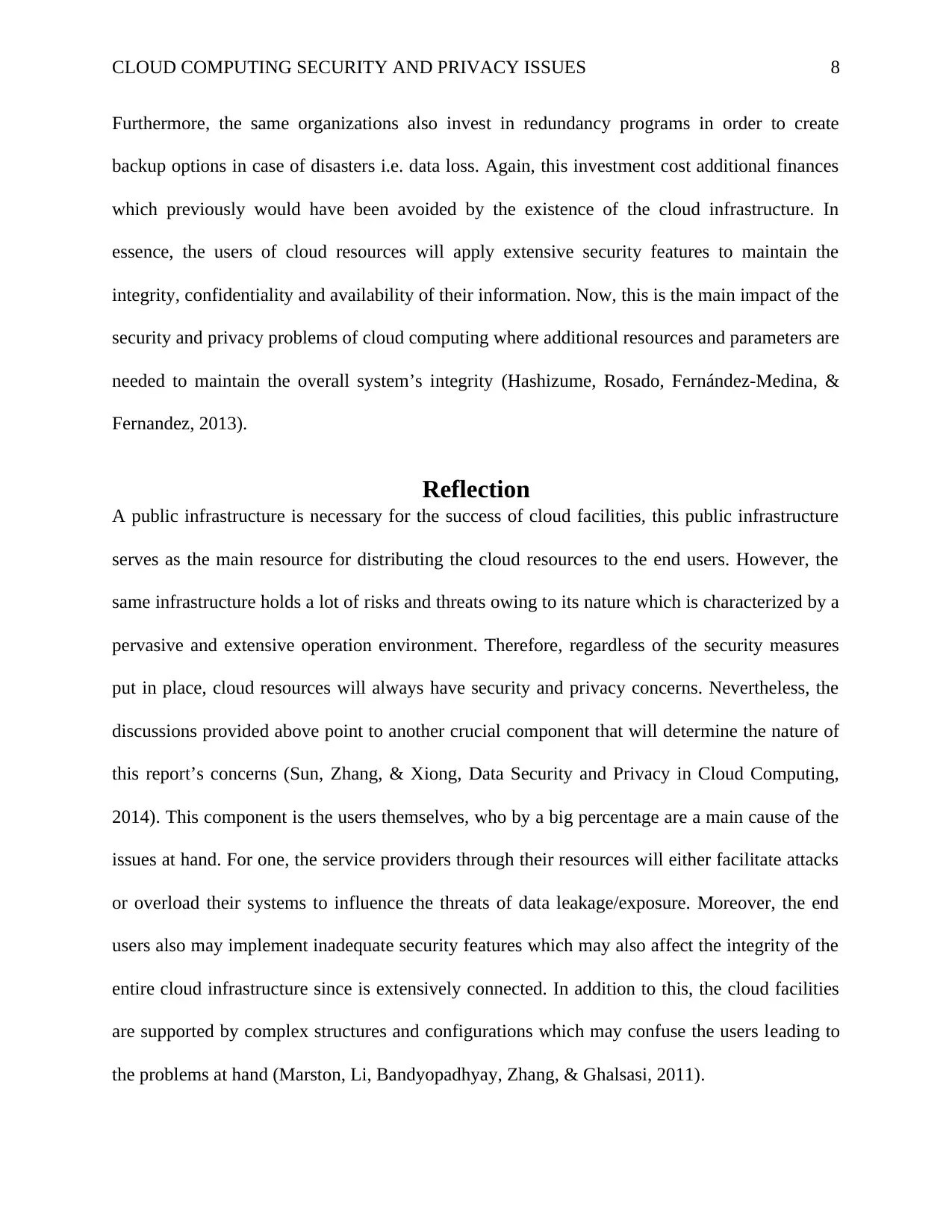
CLOUD COMPUTING SECURITY AND PRIVACY ISSUES 8
Furthermore, the same organizations also invest in redundancy programs in order to create
backup options in case of disasters i.e. data loss. Again, this investment cost additional finances
which previously would have been avoided by the existence of the cloud infrastructure. In
essence, the users of cloud resources will apply extensive security features to maintain the
integrity, confidentiality and availability of their information. Now, this is the main impact of the
security and privacy problems of cloud computing where additional resources and parameters are
needed to maintain the overall system’s integrity (Hashizume, Rosado, Fernández-Medina, &
Fernandez, 2013).
Reflection
A public infrastructure is necessary for the success of cloud facilities, this public infrastructure
serves as the main resource for distributing the cloud resources to the end users. However, the
same infrastructure holds a lot of risks and threats owing to its nature which is characterized by a
pervasive and extensive operation environment. Therefore, regardless of the security measures
put in place, cloud resources will always have security and privacy concerns. Nevertheless, the
discussions provided above point to another crucial component that will determine the nature of
this report’s concerns (Sun, Zhang, & Xiong, Data Security and Privacy in Cloud Computing,
2014). This component is the users themselves, who by a big percentage are a main cause of the
issues at hand. For one, the service providers through their resources will either facilitate attacks
or overload their systems to influence the threats of data leakage/exposure. Moreover, the end
users also may implement inadequate security features which may also affect the integrity of the
entire cloud infrastructure since is extensively connected. In addition to this, the cloud facilities
are supported by complex structures and configurations which may confuse the users leading to
the problems at hand (Marston, Li, Bandyopadhyay, Zhang, & Ghalsasi, 2011).
Furthermore, the same organizations also invest in redundancy programs in order to create
backup options in case of disasters i.e. data loss. Again, this investment cost additional finances
which previously would have been avoided by the existence of the cloud infrastructure. In
essence, the users of cloud resources will apply extensive security features to maintain the
integrity, confidentiality and availability of their information. Now, this is the main impact of the
security and privacy problems of cloud computing where additional resources and parameters are
needed to maintain the overall system’s integrity (Hashizume, Rosado, Fernández-Medina, &
Fernandez, 2013).
Reflection
A public infrastructure is necessary for the success of cloud facilities, this public infrastructure
serves as the main resource for distributing the cloud resources to the end users. However, the
same infrastructure holds a lot of risks and threats owing to its nature which is characterized by a
pervasive and extensive operation environment. Therefore, regardless of the security measures
put in place, cloud resources will always have security and privacy concerns. Nevertheless, the
discussions provided above point to another crucial component that will determine the nature of
this report’s concerns (Sun, Zhang, & Xiong, Data Security and Privacy in Cloud Computing,
2014). This component is the users themselves, who by a big percentage are a main cause of the
issues at hand. For one, the service providers through their resources will either facilitate attacks
or overload their systems to influence the threats of data leakage/exposure. Moreover, the end
users also may implement inadequate security features which may also affect the integrity of the
entire cloud infrastructure since is extensively connected. In addition to this, the cloud facilities
are supported by complex structures and configurations which may confuse the users leading to
the problems at hand (Marston, Li, Bandyopadhyay, Zhang, & Ghalsasi, 2011).
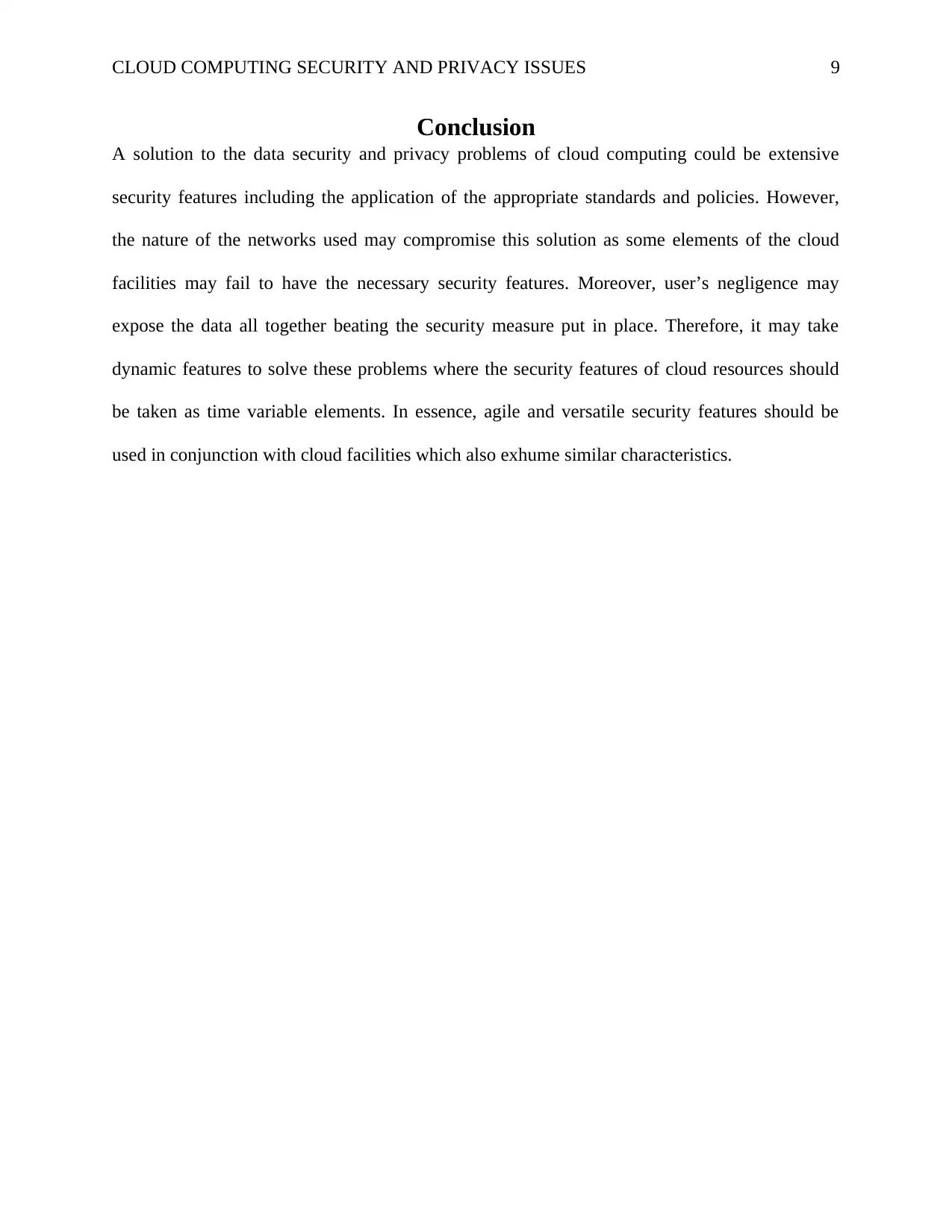
CLOUD COMPUTING SECURITY AND PRIVACY ISSUES 9
Conclusion
A solution to the data security and privacy problems of cloud computing could be extensive
security features including the application of the appropriate standards and policies. However,
the nature of the networks used may compromise this solution as some elements of the cloud
facilities may fail to have the necessary security features. Moreover, user’s negligence may
expose the data all together beating the security measure put in place. Therefore, it may take
dynamic features to solve these problems where the security features of cloud resources should
be taken as time variable elements. In essence, agile and versatile security features should be
used in conjunction with cloud facilities which also exhume similar characteristics.
Conclusion
A solution to the data security and privacy problems of cloud computing could be extensive
security features including the application of the appropriate standards and policies. However,
the nature of the networks used may compromise this solution as some elements of the cloud
facilities may fail to have the necessary security features. Moreover, user’s negligence may
expose the data all together beating the security measure put in place. Therefore, it may take
dynamic features to solve these problems where the security features of cloud resources should
be taken as time variable elements. In essence, agile and versatile security features should be
used in conjunction with cloud facilities which also exhume similar characteristics.
⊘ This is a preview!⊘
Do you want full access?
Subscribe today to unlock all pages.

Trusted by 1+ million students worldwide
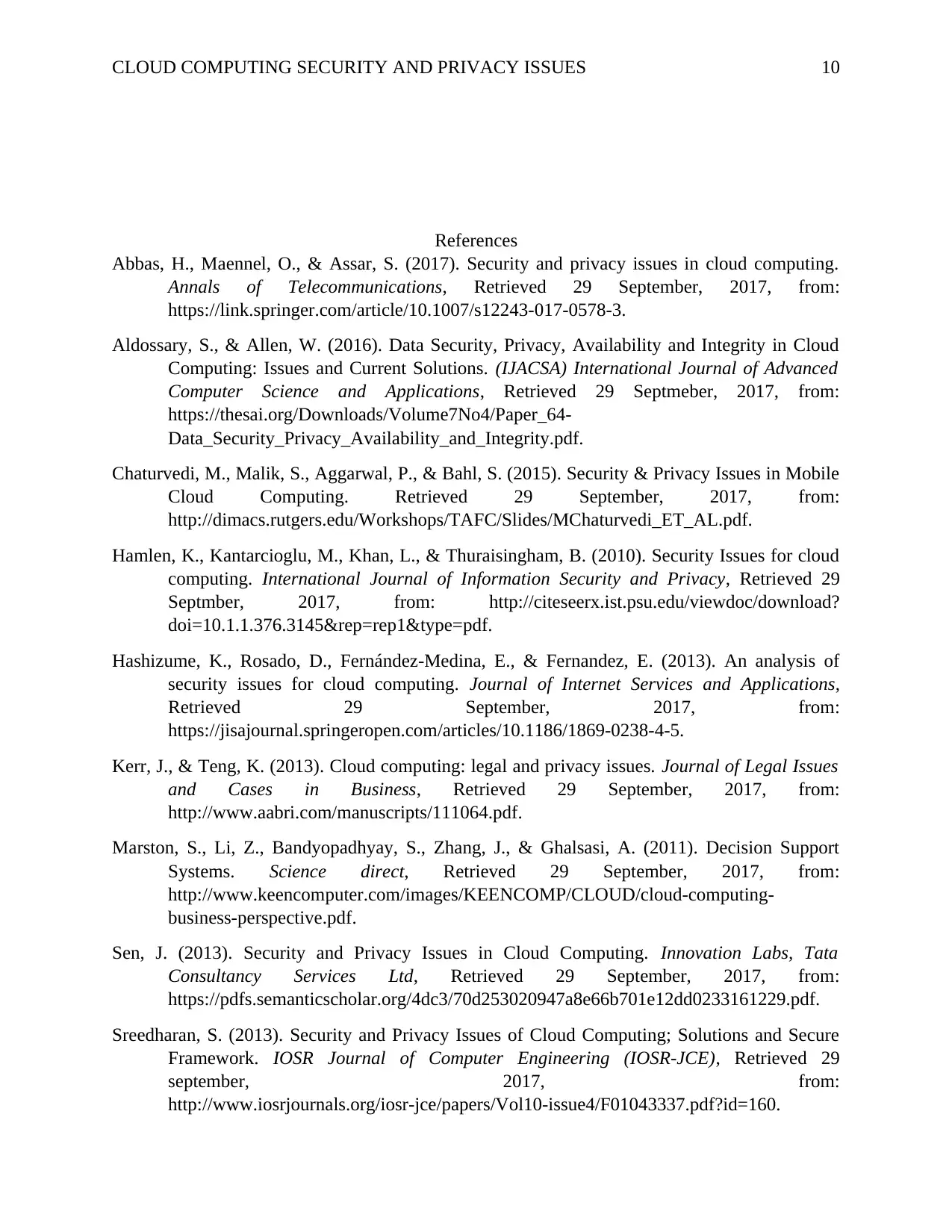
CLOUD COMPUTING SECURITY AND PRIVACY ISSUES 10
References
Abbas, H., Maennel, O., & Assar, S. (2017). Security and privacy issues in cloud computing.
Annals of Telecommunications, Retrieved 29 September, 2017, from:
https://link.springer.com/article/10.1007/s12243-017-0578-3.
Aldossary, S., & Allen, W. (2016). Data Security, Privacy, Availability and Integrity in Cloud
Computing: Issues and Current Solutions. (IJACSA) International Journal of Advanced
Computer Science and Applications, Retrieved 29 Septmeber, 2017, from:
https://thesai.org/Downloads/Volume7No4/Paper_64-
Data_Security_Privacy_Availability_and_Integrity.pdf.
Chaturvedi, M., Malik, S., Aggarwal, P., & Bahl, S. (2015). Security & Privacy Issues in Mobile
Cloud Computing. Retrieved 29 September, 2017, from:
http://dimacs.rutgers.edu/Workshops/TAFC/Slides/MChaturvedi_ET_AL.pdf.
Hamlen, K., Kantarcioglu, M., Khan, L., & Thuraisingham, B. (2010). Security Issues for cloud
computing. International Journal of Information Security and Privacy, Retrieved 29
Septmber, 2017, from: http://citeseerx.ist.psu.edu/viewdoc/download?
doi=10.1.1.376.3145&rep=rep1&type=pdf.
Hashizume, K., Rosado, D., Fernández-Medina, E., & Fernandez, E. (2013). An analysis of
security issues for cloud computing. Journal of Internet Services and Applications,
Retrieved 29 September, 2017, from:
https://jisajournal.springeropen.com/articles/10.1186/1869-0238-4-5.
Kerr, J., & Teng, K. (2013). Cloud computing: legal and privacy issues. Journal of Legal Issues
and Cases in Business, Retrieved 29 September, 2017, from:
http://www.aabri.com/manuscripts/111064.pdf.
Marston, S., Li, Z., Bandyopadhyay, S., Zhang, J., & Ghalsasi, A. (2011). Decision Support
Systems. Science direct, Retrieved 29 September, 2017, from:
http://www.keencomputer.com/images/KEENCOMP/CLOUD/cloud-computing-
business-perspective.pdf.
Sen, J. (2013). Security and Privacy Issues in Cloud Computing. Innovation Labs, Tata
Consultancy Services Ltd, Retrieved 29 September, 2017, from:
https://pdfs.semanticscholar.org/4dc3/70d253020947a8e66b701e12dd0233161229.pdf.
Sreedharan, S. (2013). Security and Privacy Issues of Cloud Computing; Solutions and Secure
Framework. IOSR Journal of Computer Engineering (IOSR-JCE), Retrieved 29
september, 2017, from:
http://www.iosrjournals.org/iosr-jce/papers/Vol10-issue4/F01043337.pdf?id=160.
References
Abbas, H., Maennel, O., & Assar, S. (2017). Security and privacy issues in cloud computing.
Annals of Telecommunications, Retrieved 29 September, 2017, from:
https://link.springer.com/article/10.1007/s12243-017-0578-3.
Aldossary, S., & Allen, W. (2016). Data Security, Privacy, Availability and Integrity in Cloud
Computing: Issues and Current Solutions. (IJACSA) International Journal of Advanced
Computer Science and Applications, Retrieved 29 Septmeber, 2017, from:
https://thesai.org/Downloads/Volume7No4/Paper_64-
Data_Security_Privacy_Availability_and_Integrity.pdf.
Chaturvedi, M., Malik, S., Aggarwal, P., & Bahl, S. (2015). Security & Privacy Issues in Mobile
Cloud Computing. Retrieved 29 September, 2017, from:
http://dimacs.rutgers.edu/Workshops/TAFC/Slides/MChaturvedi_ET_AL.pdf.
Hamlen, K., Kantarcioglu, M., Khan, L., & Thuraisingham, B. (2010). Security Issues for cloud
computing. International Journal of Information Security and Privacy, Retrieved 29
Septmber, 2017, from: http://citeseerx.ist.psu.edu/viewdoc/download?
doi=10.1.1.376.3145&rep=rep1&type=pdf.
Hashizume, K., Rosado, D., Fernández-Medina, E., & Fernandez, E. (2013). An analysis of
security issues for cloud computing. Journal of Internet Services and Applications,
Retrieved 29 September, 2017, from:
https://jisajournal.springeropen.com/articles/10.1186/1869-0238-4-5.
Kerr, J., & Teng, K. (2013). Cloud computing: legal and privacy issues. Journal of Legal Issues
and Cases in Business, Retrieved 29 September, 2017, from:
http://www.aabri.com/manuscripts/111064.pdf.
Marston, S., Li, Z., Bandyopadhyay, S., Zhang, J., & Ghalsasi, A. (2011). Decision Support
Systems. Science direct, Retrieved 29 September, 2017, from:
http://www.keencomputer.com/images/KEENCOMP/CLOUD/cloud-computing-
business-perspective.pdf.
Sen, J. (2013). Security and Privacy Issues in Cloud Computing. Innovation Labs, Tata
Consultancy Services Ltd, Retrieved 29 September, 2017, from:
https://pdfs.semanticscholar.org/4dc3/70d253020947a8e66b701e12dd0233161229.pdf.
Sreedharan, S. (2013). Security and Privacy Issues of Cloud Computing; Solutions and Secure
Framework. IOSR Journal of Computer Engineering (IOSR-JCE), Retrieved 29
september, 2017, from:
http://www.iosrjournals.org/iosr-jce/papers/Vol10-issue4/F01043337.pdf?id=160.
Paraphrase This Document
Need a fresh take? Get an instant paraphrase of this document with our AI Paraphraser
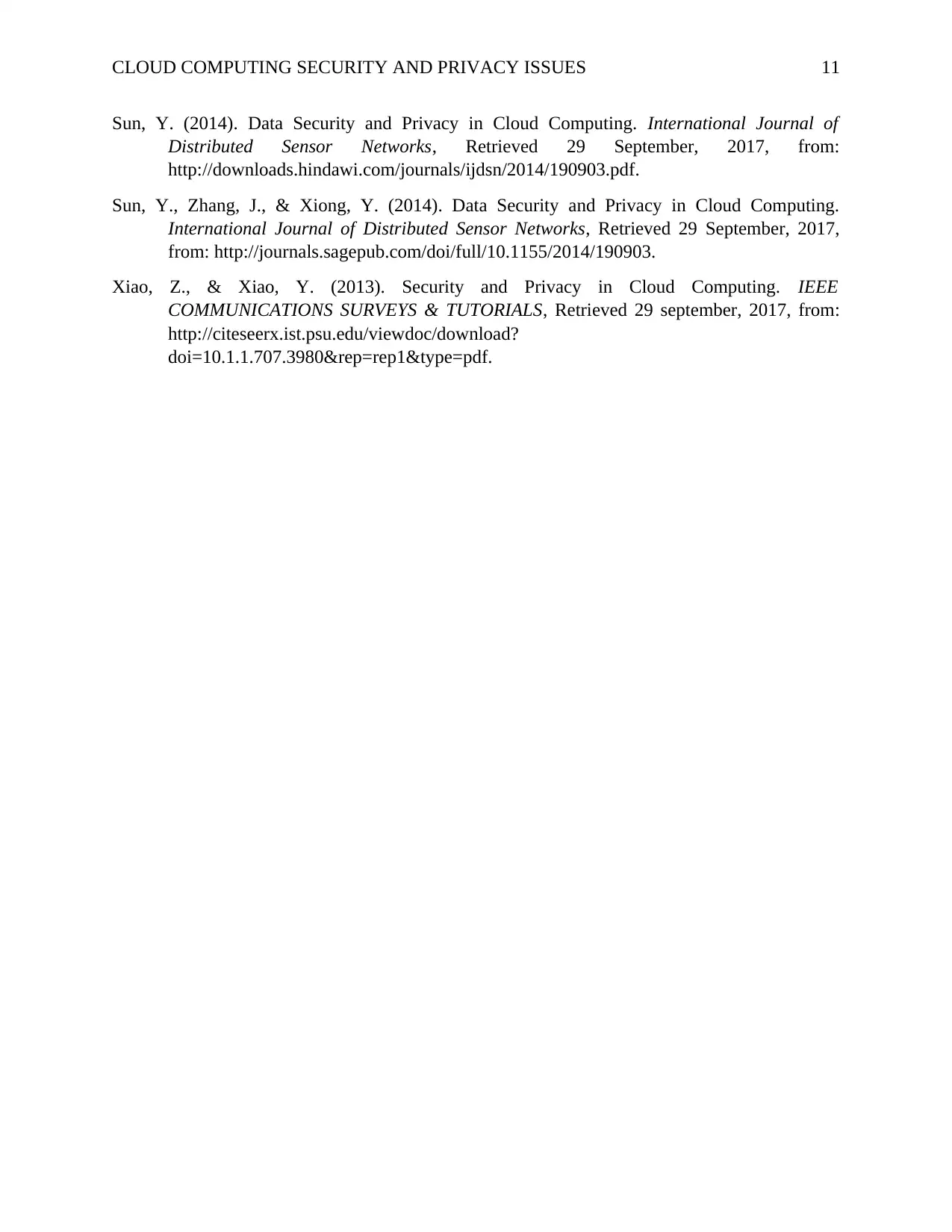
CLOUD COMPUTING SECURITY AND PRIVACY ISSUES 11
Sun, Y. (2014). Data Security and Privacy in Cloud Computing. International Journal of
Distributed Sensor Networks, Retrieved 29 September, 2017, from:
http://downloads.hindawi.com/journals/ijdsn/2014/190903.pdf.
Sun, Y., Zhang, J., & Xiong, Y. (2014). Data Security and Privacy in Cloud Computing.
International Journal of Distributed Sensor Networks, Retrieved 29 September, 2017,
from: http://journals.sagepub.com/doi/full/10.1155/2014/190903.
Xiao, Z., & Xiao, Y. (2013). Security and Privacy in Cloud Computing. IEEE
COMMUNICATIONS SURVEYS & TUTORIALS, Retrieved 29 september, 2017, from:
http://citeseerx.ist.psu.edu/viewdoc/download?
doi=10.1.1.707.3980&rep=rep1&type=pdf.
Sun, Y. (2014). Data Security and Privacy in Cloud Computing. International Journal of
Distributed Sensor Networks, Retrieved 29 September, 2017, from:
http://downloads.hindawi.com/journals/ijdsn/2014/190903.pdf.
Sun, Y., Zhang, J., & Xiong, Y. (2014). Data Security and Privacy in Cloud Computing.
International Journal of Distributed Sensor Networks, Retrieved 29 September, 2017,
from: http://journals.sagepub.com/doi/full/10.1155/2014/190903.
Xiao, Z., & Xiao, Y. (2013). Security and Privacy in Cloud Computing. IEEE
COMMUNICATIONS SURVEYS & TUTORIALS, Retrieved 29 september, 2017, from:
http://citeseerx.ist.psu.edu/viewdoc/download?
doi=10.1.1.707.3980&rep=rep1&type=pdf.
1 out of 11
Related Documents
Your All-in-One AI-Powered Toolkit for Academic Success.
+13062052269
info@desklib.com
Available 24*7 on WhatsApp / Email
![[object Object]](/_next/static/media/star-bottom.7253800d.svg)
Unlock your academic potential
Copyright © 2020–2025 A2Z Services. All Rights Reserved. Developed and managed by ZUCOL.




